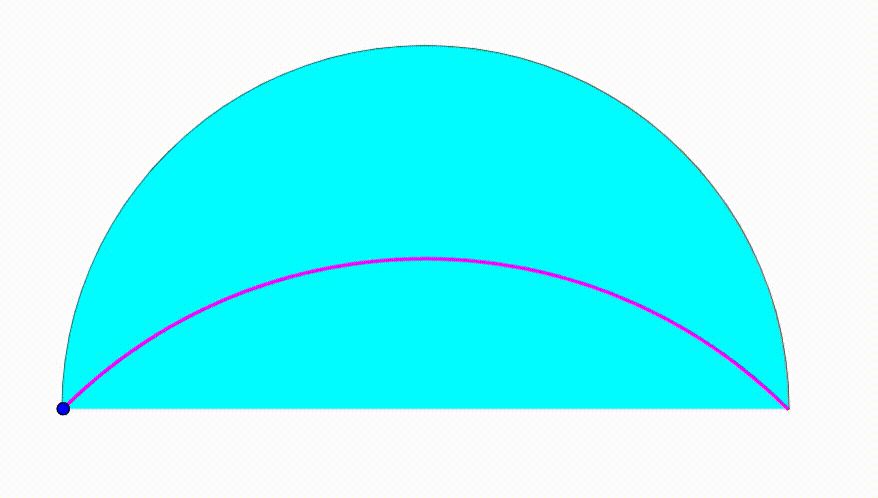Dynamic Geometry: P67
 The diagram shows a black semicircle with radius
. The yellow and the cyan semicircle are tangent to each other and internally tangent to the black semicircle. They are growing and shrinking freely so that the sum of their radius is always equal to
. We inscribe a green circle so that it's tangent to all three semicircles. The intersection points between the green circle and the two moving semicircles trace a
locus
(purple curve). The area bounded by the purple curve and the diameter of the black semicircle can be expressed as
, where
and
are positive integers. Find
.
The diagram shows a black semicircle with radius
. The yellow and the cyan semicircle are tangent to each other and internally tangent to the black semicircle. They are growing and shrinking freely so that the sum of their radius is always equal to
. We inscribe a green circle so that it's tangent to all three semicircles. The intersection points between the green circle and the two moving semicircles trace a
locus
(purple curve). The area bounded by the purple curve and the diameter of the black semicircle can be expressed as
, where
and
are positive integers. Find
.
The answer is 1.
This section requires Javascript.
You are seeing this because something didn't load right. We suggest you, (a) try
refreshing the page, (b) enabling javascript if it is disabled on your browser and,
finally, (c)
loading the
non-javascript version of this page
. We're sorry about the hassle.
Label the diagram as follows, and let θ = ∠ H B E , r be the radius of the yellow semicircle, and R be the radius of the green circle:
Since the black semicircle has a radius of 1 , A F = 2 , so the radius of the cyan semicircle is 2 1 C F = 2 1 ( A F − A C ) = 2 1 ( 2 − 2 r ) = 1 − r .
That means B D = A D − A B = 1 − r , B H = B I + I H = r + R , H E = H J + J E = R + 1 − r , B E = A F − A B − E F = 2 − r − ( 1 − r ) = 1 , and H D = G D − G H = 1 − R .
By the law of cosines on △ H B D , cos θ = 2 ⋅ B D ⋅ B H B D 2 + B H 2 − H D 2 = 2 ⋅ ( 1 − r ) ⋅ ( r + R ) ( r + R ) 2 + ( r + R ) 2 − ( 1 − R ) 2 .
By the law of cosines on △ H B E , cos θ = 2 ⋅ B E ⋅ B H B E 2 + B H 2 − H E 2 = 2 ⋅ 1 ⋅ ( r + R ) 1 2 + ( r + R ) 2 − ( R + 1 − r ) 2
So cos θ = 2 ⋅ ( 1 − r ) ⋅ ( r + R ) ( r + R ) 2 + ( r + R ) 2 − ( 1 − R ) 2 = 2 ⋅ 1 ⋅ ( r + R ) 1 2 + ( r + R ) 2 − ( R + 1 − r ) 2 , which rearranges to R = r 2 − r + 1 r ( 1 − r ) .
Substituting R = r 2 − r + 1 r ( 1 − r ) into cos θ = 2 ⋅ ( 1 − r ) ⋅ ( r + R ) ( r + R ) 2 + ( r + R ) 2 − ( 1 − R ) 2 simplifies to cos θ = r 2 − 2 r + 2 ( 2 − r ) r .
If D is placed at the origin, then I has an x -coordinate of x = r − 1 + r cos θ and a y -coordinate of y = r sin θ = r 1 − cos 2 θ .
Substituting cos θ = r 2 − 2 r + 2 ( 2 − r ) r and combining gives x 2 + ( y + 1 ) 2 = 2 , so the purple locus is a fourth of a circle with a center of ( 0 , − 1 ) and a radius of 2 .
The area bounded by the purple curve and the diameter of the black semicircle is then 4 1 π ( 2 ) 2 − 2 1 ( 2 ) 2 = 2 π − 1 , so p = 2 , q = 1 , and p − q = 1 .